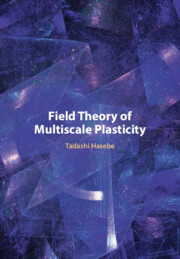Book contents
- Field Theory of Multiscale Plasticity
- Field Theory of Multiscale Plasticity
- Copyright page
- Contents
- Preface
- Acknowledgments
- Part I Fundamentals
- 1 Dislocation Theory and Metallurgy
- 2 Dislocation Dynamics and Constitutive Framework
- 3 Dislocation Substructures
- 4 Single Crystals versus Polycrystals
- Part II Theoretical Backgrounds
- Part III Applications I
- Part IV Applications II
- References
- Author Index
- Subject Index
1 - Dislocation Theory and Metallurgy
from Part I - Fundamentals
Published online by Cambridge University Press: 14 December 2023
- Field Theory of Multiscale Plasticity
- Field Theory of Multiscale Plasticity
- Copyright page
- Contents
- Preface
- Acknowledgments
- Part I Fundamentals
- 1 Dislocation Theory and Metallurgy
- 2 Dislocation Dynamics and Constitutive Framework
- 3 Dislocation Substructures
- 4 Single Crystals versus Polycrystals
- Part II Theoretical Backgrounds
- Part III Applications I
- Part IV Applications II
- References
- Author Index
- Subject Index
Summary
This Chapter first presents a minimal set of basic concepts about “dislocations.” After giving a brief overview of the dislocation theory, specific notions such as “Lomer-Cottrell sessile junction” and “stacking fault energy” are detailed, which are exceptionally important for a comprehensive understanding of many of the characteristics, particularly, dislocation-dislocation interactions and their strengths. The second part provides a simple introduction to metallurgy, especially regarding crystallographic structures, placing a special emphasis on the substantial distinction between face-centered cubic (FCC) and body-centered cubic (BCC) structures, which is expected to greatly facilitate further understanding of the associated contrasting features between the two.
- Type
- Chapter
- Information
- Field Theory of Multiscale Plasticity , pp. 3 - 85Publisher: Cambridge University PressPrint publication year: 2024

